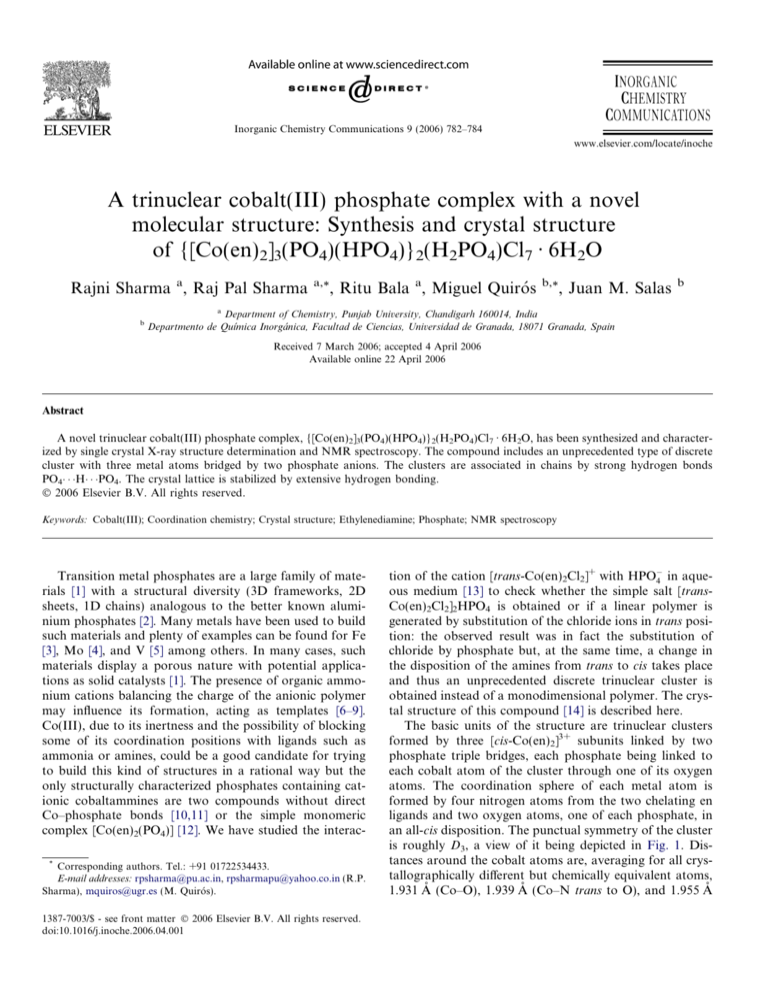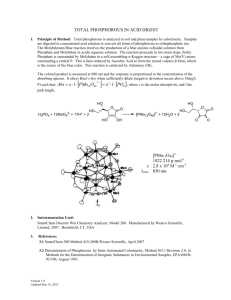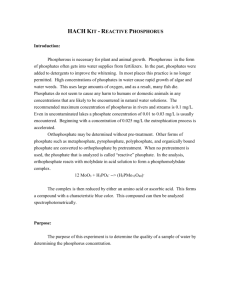
Inorganic Chemistry Communications 9 (2006) 782–784
www.elsevier.com/locate/inoche
A trinuclear cobalt(III) phosphate complex with a novel
molecular structure: Synthesis and crystal structure
of {[Co(en)2]3(PO4)(HPO4)}2(H2PO4)Cl7 Æ 6H2O
Rajni Sharma a, Raj Pal Sharma
b
a,*
, Ritu Bala a, Miguel Quirós
b,*
, Juan M. Salas
b
a
Department of Chemistry, Punjab University, Chandigarh 160014, India
Departmento de Quı́mica Inorgánica, Facultad de Ciencias, Universidad de Granada, 18071 Granada, Spain
Received 7 March 2006; accepted 4 April 2006
Available online 22 April 2006
Abstract
A novel trinuclear cobalt(III) phosphate complex, {[Co(en)2]3(PO4)(HPO4)}2(H2PO4)Cl7 Æ 6H2O, has been synthesized and characterized by single crystal X-ray structure determination and NMR spectroscopy. The compound includes an unprecedented type of discrete
cluster with three metal atoms bridged by two phosphate anions. The clusters are associated in chains by strong hydrogen bonds
PO4 H PO4. The crystal lattice is stabilized by extensive hydrogen bonding.
2006 Elsevier B.V. All rights reserved.
Keywords: Cobalt(III); Coordination chemistry; Crystal structure; Ethylenediamine; Phosphate; NMR spectroscopy
Transition metal phosphates are a large family of materials [1] with a structural diversity (3D frameworks, 2D
sheets, 1D chains) analogous to the better known aluminium phosphates [2]. Many metals have been used to build
such materials and plenty of examples can be found for Fe
[3], Mo [4], and V [5] among others. In many cases, such
materials display a porous nature with potential applications as solid catalysts [1]. The presence of organic ammonium cations balancing the charge of the anionic polymer
may influence its formation, acting as templates [6–9].
Co(III), due to its inertness and the possibility of blocking
some of its coordination positions with ligands such as
ammonia or amines, could be a good candidate for trying
to build this kind of structures in a rational way but the
only structurally characterized phosphates containing cationic cobaltammines are two compounds without direct
Co–phosphate bonds [10,11] or the simple monomeric
complex [Co(en)2(PO4)] [12]. We have studied the interac*
Corresponding authors. Tel.: +91 01722534433.
E-mail addresses: rpsharma@pu.ac.in, rpsharmapu@yahoo.co.in (R.P.
Sharma), mquiros@ugr.es (M. Quirós).
1387-7003/$ - see front matter 2006 Elsevier B.V. All rights reserved.
doi:10.1016/j.inoche.2006.04.001
tion of the cation [trans-Co(en)2Cl2]+ with HPO
4 in aqueous medium [13] to check whether the simple salt [transCo(en)2Cl2]2HPO4 is obtained or if a linear polymer is
generated by substitution of the chloride ions in trans position: the observed result was in fact the substitution of
chloride by phosphate but, at the same time, a change in
the disposition of the amines from trans to cis takes place
and thus an unprecedented discrete trinuclear cluster is
obtained instead of a monodimensional polymer. The crystal structure of this compound [14] is described here.
The basic units of the structure are trinuclear clusters
formed by three [cis-Co(en)2]3+ subunits linked by two
phosphate triple bridges, each phosphate being linked to
each cobalt atom of the cluster through one of its oxygen
atoms. The coordination sphere of each metal atom is
formed by four nitrogen atoms from the two chelating en
ligands and two oxygen atoms, one of each phosphate, in
an all-cis disposition. The punctual symmetry of the cluster
is roughly D3, a view of it being depicted in Fig. 1. Distances around the cobalt atoms are, averaging for all crystallographically different but chemically equivalent atoms,
1.931 Å (Co–O), 1.939 Å (Co–N trans to O), and 1.955 Å
R. Sharma et al. / Inorganic Chemistry Communications 9 (2006) 782–784
783
meric components with equal weight. This may be also
interpreted as the coexistence of regions of opposite chirality within the crystal.
The fourth oxygen atom of the phosphate, pointing outwards the cluster is quite close to another analogous oxygen atom of another cluster: the distance is below 2.5 Å,
typical of a very strong hydrogen bond involving an acidic
proton. Hence, we have one of the phosphates as a true
‘‘phosphate’’ whereas the other is a ‘‘monohydrogenphosphate’’. P–O(external) distances are virtually identical for
all phosphates in the clusters, indicating that we have a
dynamic situation with the proton identically shared
between the two linked oxygens. The clusters are then linearly arranged along the c axis as follow, alternating clusters of opposed chirality:
O–PO3 –[Co(en)2 ]3 –PO3 –OHO–PO3 –[Co(en)2 ]3 –PO3
–OHO–PO3 –[Co(en)2 ]3
Fig. 1. ORTEP diagram of the trinuclear cluster {[Co(en)2]3(PO)4(HPO4)}2(H2PO4)Cl7Æ6H2O.
(Co–N trans to N); the coordination octahedra are somewhat distorted, the main distortions being the chelating
N–Co–N angles (below 86) and the O–Co–O angles
(above 93.5). Phosphate groups display a slight trigonal
distortion, according to the symmetry of the cluster, the
bond distance of the P atom to the terminal O-atom being
slightly longer than the distance to the coordinated
O-atoms (ranges, 1.540–1.561 Å and 1.524–1.540 Å,
respectively, for P–Ot and P–Oc) and bond angles being
above tetrahedral for Oc–P–Oc and below tetrahedral for
Ot–P–Oc. One of the amino groups of each en ligand forms
an intracluster hydrogen bond with one of the phosphate
oxygens (N O distances ranging from 2.83 to 3.00 Å),
six such H-bonds are present in each cluster (see Fig. 1)
contributing to its stability.
To our knowledge, this trinuclear Co(III)–phosphate
cluster is unprecedented, although Co3(PO4)2 subunits can
be found as a portion of extended polymeric species [16].
Neither we have found any example for other metal atoms
with inorganic phosphates, the only analogous clusters that
we have been able to find being two compounds containing
Cu(II) [17] or Zn(II) [18] and organic phosphates. On the
other hand, many examples of polymeric materials can be
found, with the metal atoms coordinated to more than
two phosphates, which in our case is avoided by the presence of two ethylenediamine moieties in cis position.
Two crystallographically independent clusters are present in the asymmetric unit, they are chemically equivalent
except their chirality, which is opposite. Nevertheless, it
has not been possible to determine the absolute structure
of the whole crystal in the chiral group P21, the refinement
having being performed assuming a twin of both enantio-
According to this, the average formulation for each cluster is {[Co(en)2]3(PO4)(HPO4)}4+. The charge of every two
clusters is balanced by seven chloride anions and one dihydrogenphosphate ion (H2PO4). The presence of two H
atoms in this non-coordinated species is required for electrical neutrality and supported by the P–O distances (two are
appreciably shorter than the other two, values 1.480(4),
1.485(4), 1.575(5), and 1.589(4) Å); the two O-atoms with
the longest distances form fairly strong H-bonds towards
water molecules (O O distances 2.646(6) and 2.606(7) Å).
Six interstitial water molecules complete the asymmetric
unit, therefore the formulation for the full compound is
{[Co(en)2]3(PO4)(HPO4)}2(H2PO4)Cl7 Æ 6H2O. The co-existence of the three kind of phosphate anions in the same crystal is noteworthy: it is not a unprecedented feature [19] but, to
our knowledge, it has not been described for any cobalt compound. An extensive hydrogen bond network is present stabilizing the lattice. Apart from the mentioned intracluster
N OH-bonds, those between the coordinated phosphates
and those from the dihydrogen phosphate to water molecules, there are H-bonds from en molecules to water molecules and to phosphate oxygens of neighboring clusters
(distances N O from 2.8 to 3.0 Å), from en molecules to
chloride ions (distances N Cl from 3.15 to 3.45 Å) and
from water molecules to phosphate oxygens and other water
molecules (distances O O from 2.74 to 2.80 Å).
The 31P NMR spectrum of the compound in D2O as solvent displays an intense signal at 1.20 ppm and a weaker
one at 11.85 ppm. They may be assigned, respectively, to
the phosphate species inside the clusters, which are supposed to stand in solution, and to ionic H2 PO
4 . The signals
overlap so they cannot be separately integrated, the first
one should be four times larger than the second one.
TG and DSC diagrams of the compound show dehydration as broad and asymmetric steps starting around 120
and finishing around 200 C (endothermal peak at
162 C). The associated weight loss is 6.1% (theoretical,
5.66%) and the dehydration enthalpy is 50.9 kJ/mol of
784
R. Sharma et al. / Inorganic Chemistry Communications 9 (2006) 782–784
water. The DSC diagram displays an intense endothermal
peak at 250 C attributable to the melting of the anhydrous
compound, which is immediately followed by the pyrolitic
decomposition, which continues in several overlapped steps
ending around 800 C.
A novel cobalt(III) complex with phosphate species was
unexpectedly obtained from the reaction of [transCo(en)2Cl2]+ with monohydrogenphosphate followed by
slow evaporation in aqueous medium. The generated [cisCo(en)2]3+ unit seems to direct the formation of a trinuclear cluster.
Appendix A. Supplementary data
Supplementary data associated with this article can be
found, in the online version, at doi:10.1016/
j.inoche.2006.04.001.
References
[1] A.K. Cheetham, G. Ferey, T. Loiseau, Angew Chem. Int. Ed. 38
(1999) 3269.
[2] A recent example S.K. Rishi, B.M. Kariuki, N.J. Checker, J. Godber,
A.J. Wright, Chem. Commun. (2006) 747.
[3] J.R.D. Debord, W.M. Reiff, C.J. Warren, R.C. Haushalter, J.
Zubieta, Chem. Mater. 10 (1998) 2599.
[4] R.C. Haushalter, L.A. Mundi, Chem. Mater. 4 (1992) 31.
[5] M.I. Khan, L.M. Meyer, R.C. Haushalter, A.L. Schweitzer, J.
Zubieta, J.L. Dye, Chem. Mater. 8 (1966) 43.
[6] V. Zima, K.-H. Lii, J. Chem. Soc. Dalton Trans. (1998) 4109.
[7] Y. Song, J. Yu, Y. Li, G. Li, R. Xu, Angew. Chem. Int. Edit. 43
(2004) 2399.
[8] M. Cavellec, D. Riou, J.M. Grenèche, G. Férey, Inorg. Chem. 36
(1997) 2187.
[9] K.-H. Lii, Y.F. Huang, Chem. Commun. (1997) 839.
[10] E.N. Duelser, K.N. Raymond, Inorg. Chem. 10 (1971) 1486.
[11] K.R. Morgan, G.J. Gainsford, N.B. Milestone, Chem. Commun.
(1997) 61.
[12] B.A. Anderson, R.M. Milburn, J. MacB Harrowfield, G.B. Robertson, A.M. Sargeson, J. Am. Chem. Soc. 99 (1977) 2652.
[13] Synthesis of the title compound: an aqueous solution of 1 g
(0.003 mol) of [trans-Co(en)2Cl2]Cl in 25 ml water was added to an
stoichiometric amount of disodium hydrogen phosphate dissolved in
minimum amount of water. The mixture, when allowed to evaporate
at room temperature for one day, gave violet colored crystals suitable
for single crystal X-ray structure determination which were collected
by drawing off the mother liquor and air-dried (yield, 0.7 g, 70%
based on [trans-Co(en)2Cl2]Cl). The complex is soluble in water,
ethanol and DMSO but insoluble in acetone. The complex salt
decomposes at 190 C. The elemental analysis is consistent with the
composition {[Co(en)2]3(PO4)(HPO4)}2(H2PO4)Cl7 Æ 6 H2O. Found:
C, 15.2; N, 17.7; H, 5.9. Calculated for C24H112Cl7Co6N24O26P5:C,
15.1; N, 17.6; H, 5.9. The complex is soluble in water and stable in air.
3
M.p. > 200 C. FT IR (KBr pellets) : mðPO3
4 Þ 650, mðH2 PO4 Þ 560,
dNH2 1574 cm1 which are comparable with literature values.
Electronic spectrum (in H2O): kmax 603, 304 and 247 nm corresponding to d–d transitions typical for octahedral low spin cobalt(III) salts.
[14] Crystal data for the title compound: C24H112Cl7Co6N24O26P5,
Mr = 1909.96, monoclinic, space group P21, a = 12.8349(9) Å, b =
18.7451(13) Å, c = 16.0020(11) Å, b = 109.230(1), V = 3635.1(4) Å3,
Z = 2, Dc = 1.745 Mg/m3, l = 1.789 mm1, R (for reflections with
I > 2r(I)) = 0.0406, wR2 (for all data) = 0.0975. Data were collected
at room temperature for a crystal with dimensions
0.45 · 0.20 · 0.14 mm in a Bruker SMART APEX CCD system with
MoKa radiation. 14874 independent reflections were used for
structure solution and refinement in F2 by means of the SHELX-97
package [15]. Non-hydrogen atoms were refined anisotropically. Hatoms of ethylenediamine were introduced in ideal positions whereas
those linked to O-atoms were not included in the model. Absolute
structure could not be determined, the structure being refined as a
twin of both enantiomers with equal contributions. Complete
crystallographic data have been deposited at the Cambridge Crystallographic Data Centre (CCDC No. 298942) and may be obtained free
of charge via http://www.ccdc.cam.ac.uk/conts/retrieving.html.
[15] G.M. Sheldrick, SHELXL-97. Program for the Refinement of Crystal
Structures, University of Göttingen, Germany, 1997.
[16] X. Bu, T.E. Gier, P. Feng, G.D. Stucky, Chem. Mater. 10 (1998)
2546.
[17] F.H. Fry, P. Jensen, C.M. Kepert, L. Spiccia, Inorg. Chem. 42 (2003)
5637.
[18] F. Groß, A. Müller-Hartmann, H. Vahrenkamp, Eur. J. Inorg. Chem.
(2000) 2363.
[19] S. Natarajan, L. van Wullen, W. Klein, M. Jansen, Inorg. Chem. 42
(2003) 6265.








